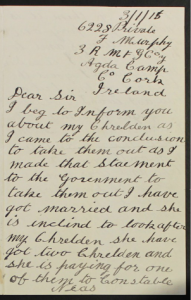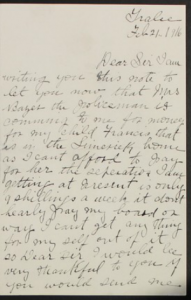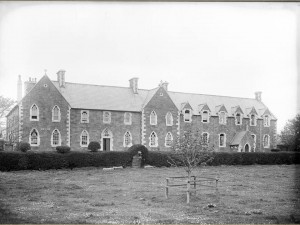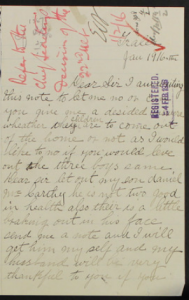by Thomas Dillon
Lecture given at Kerry County Library, Tralee on 28th April 2016 as part of the Letters of 1916 event
The Letters of 1916 project is an invaluable resource for historians researching life in Ireland one hundred years ago. This unique collection of original documents helps unearth the hidden history of life in an Irish working class household during that epoch year of Irish history. For want of historical sources, certain aspects of Irish life in the early years of the twentieth century are often overlooked. Through diaries, letters, photographs and family papers accumulated and preserved over numerous generations, some segments of society such as the gentry have a wealth of source material to give historians a well-documented insight into their lives and culture.
Unfortunately, similar records for the Irish working class from their own pen and perspective are few and far between. The vast majority of the tens of thousands of Irish men who volunteered to join the colours in the Great War were drawn from this very strata of Irish society. Digitised as part of the Letters of 1916 project, a series of four letters held in the National Archives of Ireland provide an unrivalled insight into the lives of one such Irish working class household and how the events of the First World War impacted on them.

The first letter outlines the tragic story of working class recruit Frank Murphy from Tralee whose children were committed to the industrial schools system as a direct consequence of his involvement as a soldier in the First World War. It is stamped by the Office of the Chief Inspector of the Reformatory and Industrial Schools in Dublin Castle and the Chief Secretary’s Office. Two other letters to the same recipients despatched by his wife, Hannah show her determination to secure the release of the children and tell of the emotional consequences of the family’s separation. The heartfelt requests of both Kerry parents told through their handwritten compositions are in stark contrast to the official typed response of the Chief Inspector Edward O’Farrell from Dublin Castle pronouncing the fate of their children.
The 1911 Census shows Frank Murphy was a widower living in the room of a house in Abbey Street, Tralee with his children. The Tralee man was then employed as a labourer but it is believed he was also a reservist with the local regiment, the Royal Munster Fusiliers which had its training depot at Ballymullen Barracks. The Munsters had a good relationship with the town of Tralee and many working class families in Kerry and the neighbouring counties of Cork, Clare and Limerick had close links to the regiment. The chairman of Kerry County Council, M.J. Nolan alluded to this connection in September 1914 at a meeting of people from different parts of the county in Tralee when he remarked that the Munsters were made up of their ‘…friends, relatives and neighbours…’.
Frank Murphy’s unit, the 3rd Battalion, Royal Munster Fusiliers was also known as the Kerry Militia or the Kerry Regiment. Labourers like Frank, apprentices and many of those who lived in the laneways and small streets of Kerry’s towns were to be found in its ranks along with members of the travelling community. For a few weeks each summer, the militia was embodied for training with those in attendance being paid for taking part. In common with many working class recruits all over Ireland and Britain, this annual training camp was often treated as a holiday. Recruitment to the British Army was constrained by volunteer enlistment as well as long-held concerns for the costs of a permanent standing army and the bill for long-service military pensions. In this way, the militia was a cost-effective way of ensuring there was a pool of trained soldiers which could be called on in time of war.

In his letter dated 3rd January 1916, Frank who was then 41 years old, wrote how he volunteered ‘…to fight for my Contry [sic]…’ when the First World War broke out. With the 1st Battalion, Royal Munster Fusiliers, he took part in the Gallipoli landings on the 25th April 1915. He was onboard the converted collier ship, the SS River Clyde when it was run onto the beach at Sedd el bahr in an unprecedented military experiment inspired by the ancient legend of the Horse of Troy. Well known from the Irish rebel song, the Foggy Dew, the beach was the scene of desperate fighting with hundreds killed and drowned while famously the sea ran red with Irish blood.
At some stage that day or in the early days of the campaign, Frank was wounded and invalided home to Tralee and out of the army. During his time fighting at the front, he was a single parent and it bears mention that if he had been killed in Gallipoli, his children would have been left orphans.It is not clear when they entered residential care but it most likely happened while he was serving in the army or during his time recovering from his wounds when he would have been unable to work. Following his return to Kerry, Frank did find employment in civilian life for a few months however again, the letters do not reveal if the children were in his custody during that time. The language in his letter seems to suggest he had initially accepted their committal to the industrial schools. Perhaps the family’s poverty or a concern for their well-being as a result of them being left without a parent when he was away in the war underlay his original standpoint. By January 1916, he had reconsidered this stance.
His circumstances changed dramatically on the 23rd May 1915 when he married Hannah McCarthy, a widow who had two children from her first marriage. In the months that followed, Frank was called up again and rejoined his regiment. He was stationed at Aghada in East Cork in January 1916 when he wrote to the Reformatory and Industrial Schools Office in Dublin Castle asking for the release of his children from the industrial schools. He obviously hoped informing the authorities of his new wife might mean his sons and daughter could come home, writing, ‘…I came to the conclusion to take them out as I made that staement [sic] to the Govenment [sic] to take them out I have got married and she is inclind [sic] to look after my Chrelden [sic].’.
It seems as Frank was writing these words, the custody of his wife’s own two children was hanging in the balance. Throughout Ireland during the war years, the police and the Society for the Prevention of Cruelty to Children were very active in looking out for cases of child neglect. In Tralee, the society’s inspector Michael O’Farrell and the RIC brought numerous court cases against the wives of serving soldiers who were deemed to have neglected to adequately feed, clothe and accommodate their children. By early January 1916, one of Hannah’s children had already been committed to the industrial school system with the second child being taken from her aswell at some point during the subsequent weeks.

Working class families like the Murphys lived in extreme poverty and it seems this was the main reason why the children were removed from the family home. In their letters, Frank and Hannah divulge the regular visits of RIC Constable George Neazer to collect money to pay for the upkeep of one of the children with Hannah writing, ‘…Dear Sir I am writing you this note to let you now [sic] that Mr Neazer the policeman is coming [sic] to me for money for my child Francis that is in the Limerick home as I cant [sic] afford to pay for her…’.
Hannah and the children lived down a narrow side street in Tralee located in Upper Castle Street/Boherbee at 14 Francis Street. Known also as Walpole’s Lane, Francis Street and the nearby lanes were part of the slums of Tralee. In 1916, it was an overcrowded, dirty and unhealthy place to live. To give some idea of the conditions in the laneways of Tralee around this time, an inspection reported that every house in the nearby Green Lane was found to have damp walls and no ventilation. The ground floors were also below the level of the footpath causing the dirty water and the filth of the street to accumulate in the houses which was a serious concern for the authorities struggling to cope with the control of TB and other diseases.

The extent of the poverty in which Hannah and the children lived is revealed in the 1911 Census. Forty-five families lived in Francis Street at that time with a total population of 203 people living in just 20 houses. The House and Building Return form shows how families shared the limited accommodation afforded by these houses between them. It was commonplace to see numerous families of 6-7 people residing in separate rooms of the same house. There was also one instance in the census of two families on the street, comprising 8 people sharing a single room. Though Frank and Hannah Murphy did not then live at 14 Francis Street, the census reveals the four-roomed house was then the dwelling place of 16 people divided among four families who had a room each. Often these rooms had no furniture and the family would have slept on the floor with straw for their bedding.
These were the typical living conditions of working class families in Tralee during the second decade of the twentieth century. For many, the most common way out of that poverty was to join the British Army. There was very high unemployment in Tralee following the outbreak of the war with the construction industry being particularly badly hit affecting the town’s labourers like Frank Murphy. Joining the army in a time of war was a dangerous way to have to earn a wage but at least it provided a secure source of income. With their menfolk forced to put their lives at risk to this end, it is a telling measure of the distress families like the Murphys faced.

The big attraction of joining the army during the First World War for working class families was the separation allowance which was payable to the soldier’s next of kin. It was a vital source of income however it was not enough to support Hannah and the children in the Murphy household. In one letter, Hannah writes ‘…the separation [sic] I am getting at present is only 9 shillings a week it dont [sic] nearly pay my board or way I cant [sic] get anything for myself out of it.’. It can’t be ruled out that this separation money might have served as an impetus for marriages among the working class during this period, possibly this even led to Hannah and Frank getting married as they both had children to support.
The separation money was a valuable recruiting tool and by May 1916, it was noted that 1,200 men from the town of Tralee had joined up, a figure which amounts to almost half of the documented number from the whole county of Kerry. Paid through the post office network each week, by October 1915 the average cost to the London government of the separation allowances across Ireland and Britain amounted to one million pounds per week. Rates varied according to the rank of the soldier and there were increased allowances for children but the Murphys were not getting the full rate as their children had been committed to the ‘homes’.

The letters reveal that four children, including Hannah’s own daughter, Francis were sent to ‘…the Limerick home…’ while two more, a boy and a girl were committed to the residential homes in Tralee. They were among 3,816 boys and 4,106 girls who were detained as inmates of the 65 industrial schools which operated in Ireland in 1916. Following an act of parliament in 1868, the industrial schools were established as residential institutions for neglected, abandoned and orphaned children. There were separate schools for the different religions and for boys and girls. Hannah’s little boy, Daniel McCarthy was sent to St. Joseph’s Industrial School in Balloonagh, Tralee. It had been founded in 1870 and was run by the Christian Brothers while another girl from the family was an inmate of the nearby Pembroke Alms House Industrial School for girls located in the grounds of the nearby Sisters of Mercy convent.
These ‘homes’ basically operated on the notion that certain sections of Irish society needed to be morally policed and rehabilitated. Seeking to remove children from the degradation of the workhouse environment, they sought to provide working class youths with the opportunities which were seen to have been denied to them by their birth and social background. Within the schools, the children received strict religious instruction along with being taught trades to set them up with a skill base for employment in later life. Boys were taught woodwork, tailoring or shoe making while girls were schooled in sewing, dressmaking, laundrywork and cooking. Named after the patron saint of workers, some ‘homes’ like St. Joseph’s Industrial School in Tralee operated a farm school where the children learned skills to equip them for work on a farm. Mainly funded by state grants and the local ratepayers, it was noted ‘…discipline and habits of obedience…’ were important traits ‘…cultivated…’ in the schools.
Like the workhouse, association with the ‘home’ carried a stigma which no doubt spurred on Frank and Hannah Murphy’s efforts to secure the release of their children. Their letters reveal that the children of single parents like them who were unable to cope financially were among those committed to such institutions. Others sent to these ‘homes’ included children who were truant from school, engaged in begging or those who frequented ‘…the company of reputed thieves or prostitutes…’ aswell as those from ‘bad’ households where the parents were judged to be leading a bad example through drink, crime or sexual immorality. The Murphy letters highlight the unfortunate link between working class households and the industrial school system. These institutions are a dark chapter in Ireland’s history which touched many other Irish families well into the twentieth century and long after Irish independence had been secured.

With Frank away from home with the army and their children committed to the ‘homes’, Hannah found herself left alone. Her letters uncover history at an emotional level as they shed light on her loneliness and helplessness as a mother separated from her young son and daughter. She wrote to Dublin Castle expressing her isolation writing ‘ …Dear sir if the Chief would let out the little girl or the boy that is here in Tralee as I have no one in the world as company with me…’. She was obviously in contact with the children in the ‘homes’ as in her letter dated 21st February 1916, she was particularly keen to secure the release of her son, Daniel who she was aware was ill. Highlighting her motherly desire to care for him, Hannah pleaded, ‘…Dear Sir let out my son daniel McCarthy he is not too good in health also their [sic] is a little braking [sic] out in his face send me a note and I will get him myself and my husband will be very thankful to you if you will leave him out to me as I can look after him when he is not two [sic] strong. May God send you every good Luck write to me and let me no [sic] sir.’.
When Frank wrote his letter, he drew attention to his service at the front as a soldier in the hope it would help the family’s case. He wrote how ‘…I was sick myself… but as bad as I was I volteerd [sic] to fight for my Contry [sic]…[…I…]…was called on again …[…after being wounded…]… so Dear Sir I would be pleased to know if you could let me have my Chrelden.’. There was a family home for his children in Francis Street and as Frank had returned to the army, the family would be eligible for an increased separation allowance. If the children were released, this financial bonus may have helped the household’s economic situation. This was highlighted by Hannah in one of the letters subsequently sent by her however Chief Secretary Augustine Birrell, the most senior political figure in the country, refused the release of the children in a ruling given on the 22nd January. It is clear Hannah did not accept that decision as she sent a second letter to Dublin Castle in the weeks that followed. Chief Inspector Edward O’Farrell’s further reply, dated 6th March 1916 reiterated this earlier ruling and informed Hannah Murphy that all the children must remain in the industrial schools. As challenges to the edicts of the authorities, the correspondence highlighted in this series of four letters reveals the determination of these two Kerry parents to fight against the decision of the state to separate their family.
Soldiers like Frank risked their lives to fight for ‘King and Country’ and it seemed that was not enough to accede to his request to have his children released from the industrial school system. There was a growing perception in Ireland at the time that there was nothing thought of the thousands of Irishmen who were dying in the trenches of the First World War or being maimed and seriously wounded with dire future consequences for their families at home. The resentment arose particularly after Gallipoli in 1915 when the huge Irish losses in the landings and later at Suvla Bay had basically gone unnoticed and the bravery of the Irish troops overlooked. Perhaps it is not unreasonable to suggest that the treatment of families in a similar plight to Frank and Hannah Murphy might have also added to the growing bitterness towards the authorities and the British government in Ireland which came to an irrevocable head at the time of the Easter Rising.
The four letters associated with the Murphy household in Tralee tell of the desperate reality of life for a working class family in an Irish town in 1916. They give an insight into one family’s struggle to survive together and highlight the emotional distress and the loneliness experienced by its members separated from each other as a result of poverty and war. They help put a human face to the thousands of working class Irish soldiers who fought in the First World War and uncover how family was a key reason behind their participation in the fighting. They are a valuable reminder that every one of those soldiers left behind a life and a family to answer the call to arms by Kitchener, the politicians and the church.
Life for the Murphy family had nothing to do with politics or patriotism. Their harsh experience is an aspect of 1916 far away from the well known events of the Easter Rising and the great battles of the First World War. Commemoration of the past is all about keeping historical memory alive so that it is not forgotten. Unfortunately, too often that is exactly the fate of families like the Murphys and the children of the Irish industrial school system. One of the greatest values of the Letters of 1916 project is that it encompasses this forgotten history and unwittingly acts as a memorial to stories such as theirs which might otherwise never be told.
© Thomas Dillon, 2016